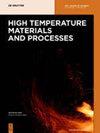High-temperature corrosion behaviours of nickel–iron-based alloys with different molybdenum and tungsten contents in a coal ash/flue gas environment
IF 1.5
4区 材料科学
Q4 MATERIALS SCIENCE, MULTIDISCIPLINARY
引用次数: 0
Abstract
Abstract High-temperature coal ash/flue gas corrosion behaviours of three nickel–iron based superalloys for boiler tubes with different Mo and W contents (1.8% Mo + 1.2% W for S1 alloy, 0.8% Mo + 0.2% W for S2 alloy, and 0.5% Mo + 2.2% W for S3 alloy) at 650 and 700°C were studied. The microstructure, phase compositions, and morphologies together with element distribution for corrosion products were investigated with a metallographic microscope, a scanning electron microscope equipped with an energy-dispersive spectroscope, and X-ray diffractometer. The results show that the corrosion resistance of the Ni–Fe-based alloy decreases with the increasing total content of Mo and W in the alloy at both 650 and 700°C; the outer layer of the corrosion products was mainly composed of FeCr2O4 while the inner layer was mainly composed of Cr2O3. Peeling of the oxide films formed on the surfaces of S1 and S3 alloys was observed but no obvious spalling was observed for the S2 alloy. The reactions among Mo, W, and S in the coal ash/flue gas increased the internal stress in the oxide scale, which would cause the failure of the oxide scale. Graphical Abstract High-temperature corrosion behaviours of three nickel–iron-based superalloys for boiler tubes with different Mo and W contents in simulated coal ash/flue gas at 650 and 700°C were studied. The corrosion resistance of the Ni–Fe-based alloy decreases with the increasing total contents of Mo and W in the alloy at both 650 and 700°C; peeling of the oxide films formed on the surfaces of S1 and S3 alloys was observed but no obvious spalling was observed for the S2 alloy. Reactions between Mo, W, and S in the coal ash/flue gas increased the internal stress in the oxide scale, which would cause the failure of the oxide scale.不同钼和钨含量的镍铁合金在煤灰/烟气环境中的高温腐蚀行为
摘要研究了三种不同Mo和W含量的镍铁基高温合金(S1合金为1.8%Mo+1.2%W,S2合金为0.8%Mo+0.2%W,S3合金为0.5%Mo+2.2%W)在650和700°C下对锅炉管的高温煤灰/烟气腐蚀行为。用金相显微镜、带能谱仪的扫描电子显微镜和X射线衍射仪研究了腐蚀产物的微观结构、相组成、形貌以及元素分布。结果表明,在650°C和700°C下,Ni–Fe基合金的耐蚀性随着合金中Mo和W总含量的增加而降低;腐蚀产物的外层主要由FeCr2O4组成,而内层主要由Cr2O3组成。观察到S1和S3合金表面上形成的氧化膜剥落,但S2合金没有观察到明显的剥落。煤灰/烟气中Mo、W和S之间的反应增加了氧化皮中的内应力,这将导致氧化皮的失效。研究了三种不同Mo和W含量的镍铁基高温合金在650和700°C模拟煤灰/烟气中对锅炉管的高温腐蚀行为。在650°C和700°C下,Ni–Fe基合金的耐蚀性随着合金中Mo和W总含量的增加而降低;观察到在S1和S3合金的表面上形成的氧化膜的剥离,但是对于S2合金没有观察到明显的剥落。煤灰/烟气中Mo、W和S之间的反应增加了氧化皮中的内应力,这将导致氧化皮的失效。
本文章由计算机程序翻译,如有差异,请以英文原文为准。
求助全文
约1分钟内获得全文
求助全文
来源期刊

High Temperature Materials and Processes
工程技术-材料科学:综合
CiteScore
2.50
自引率
0.00%
发文量
42
审稿时长
3.9 months
期刊介绍:
High Temperature Materials and Processes offers an international publication forum for new ideas, insights and results related to high-temperature materials and processes in science and technology. The journal publishes original research papers and short communications addressing topics at the forefront of high-temperature materials research including processing of various materials at high temperatures. Occasionally, reviews of a specific topic are included. The journal also publishes special issues featuring ongoing research programs as well as symposia of high-temperature materials and processes, and other related research activities.
Emphasis is placed on the multi-disciplinary nature of high-temperature materials and processes for various materials in a variety of states. Such a nature of the journal will help readers who wish to become acquainted with related subjects by obtaining information of various aspects of high-temperature materials research. The increasing spread of information on these subjects will also help to shed light on relevant topics of high-temperature materials and processes outside of readers’ own core specialties.
 求助内容:
求助内容: 应助结果提醒方式:
应助结果提醒方式:


